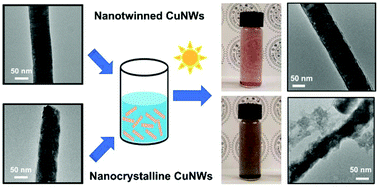Enhanced photolysis stability of Cu2O grown on Cu nanowires with nanoscale twin boundaries†
Abstract
Cuprous oxide (Cu2O) that has a direct bandgap corresponding to visible-light absorption exhibits versatile functionalities, which are appealing to solar cell, photocatalyst, bio-sensing and water splitting applications. However, photolysis stability has long been a problem for Cu2O under light exposure and a humid environment. Here, we found that the Cu2O layer grown on Cu nanowires (CuNWs) with high-density nanoscale twin boundaries can maintain the integrity of Cu/Cu2O core–shell structure under ambient air conditions for more than one year. The Cu2O on nanotwinned CuNWs also demonstrates much higher stability in humid air and water with light exposure than its counterpart on nanocrystalline CuNWs. The superior photolysis stability of Cu2O is attributed to (1) photoelectrons drained to the Cu core, (2) limited vacancy sources in the Cu2O layer and (3) the suppressed out-diffusion of Cu cations through the oxide layer. It is suggested that the presence of nanoscale twin boundaries modifies the atomic surface structure of the CuNWs and alters the photolysis reaction of Cu2O.



 Please wait while we load your content...
Please wait while we load your content...